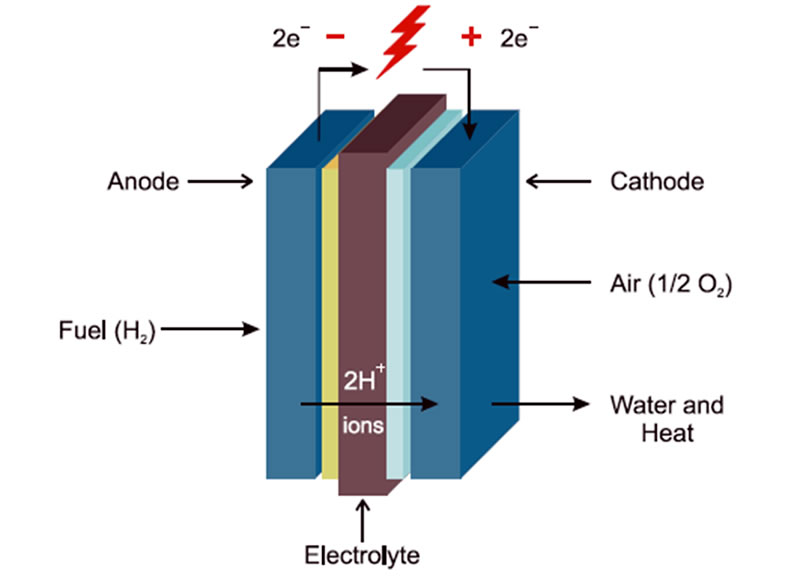Hydrogen Utilization
Hydrogen can be utilized electrochemically or thermochemically, the corresponding technologies are shown below.
Hydrogen Fuel Cell
Hydrogen fuel cells are electrochemical devices, that exploit a series of chemical reactions to generate electricity. Fuel cells operate on hydrogen and oxygen (supplied as a component of air). The 1990s were marked as the first period when mass production and widespread utilization of the fuel cell began. It is also important to mention that the global capacity for electricity produced from fuel cells is estimated to be between 1GW and 2GW. A conventional fuel cell contains an electrolyte and two electrodes. The electrolyte acts as a semipermeable membrane that allows the passage of positively charged atoms(such as protons). Diatomic hydrogen is characterized by a neutral charge, therefore, in order to penetrate the membrane, the catalyst acts in order to separate the electron from the proton (H+). Protons are now able to penetrate the electrolyte, however, in order to react with oxygen, the electrons detached from the individual hydrogen atoms must be transported to the cathode chamber, the transfer is completed by means of connecting an external circuit to the electrodes. The byproducts of such a device are water and heat.
We can summarize the FC operation principle as shown below
It is easy to see that hydrogen fuel cells are capable of powering any electricity–supplied system, be it a household appliance, a heating system, or use in the various energy-intensive applications of individual or industrial activities (Transportation, Metallurgy eg.).
Hydrogen Internal Combustion Engine
The excessive use of hydrocarbon internal combustion-gasification technology for the bulk of industrial applications over the last three centuries, almost exclusively, bears responsibility for the impending Climate Change as The Greenhouse Effect has become a global issue in recent decades. Technology for production of mechanical energy-useful work through exploiting an expanding gaseous mixture is one of the most important technological breakthroughs and it is possible for it to continue to be widely implemented, with the prerequisite of drastic reduction and eventual annihilation of emissions of gaseous pollutants. In this context, Hydrogen can replace Hydrocarbons of all types and meet the requirements of each application without producing CO2 as it ignites. It is a fact, however, that the HICE Powertrain (Hydrogen Internal Combustion Engine) differs compared to a conventional diesel or petrol internal combustion powertrain. There are commercially available models of such engines and the imminent imposition of fines for the owners of machinery or means of transportation that produce Greenhouse gas emissions makes the internal combustion of hydrocarbons an extremely short-term, non-viable solution, especially as technological development allows cost-competitive mass production of hydrogen, which is directly usable and able to meet energy needs without polluting the environment.



